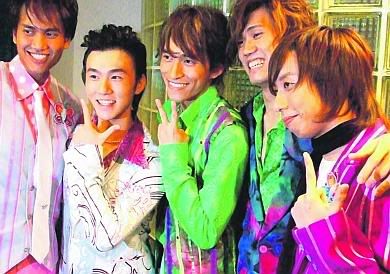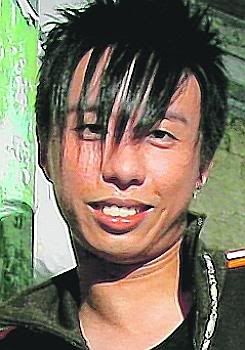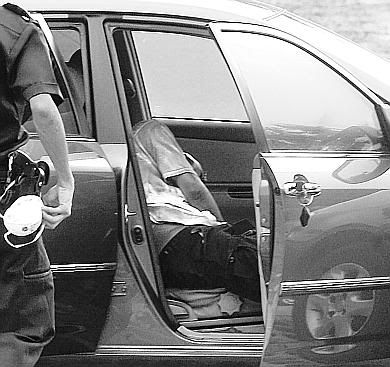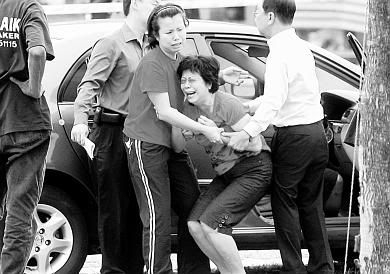16 Sep 2007, ST
By Bertha Henson
MY GRANDMOTHER died at home, surrounded by her children and grandchildren. We wept quietly and prayed silently as we watched her slip away slowly.
It was agonising to watch her, as her pauses in between breaths got longer and longer.
And when she finally breathed her last, all hell broke loose. The weeping became bawling, prayers turned into a chorus of chants.
A relative who is a doctor was asked to certify her death, then undertakers came to take her body away. When she returned in her casket, she looked beautiful.
I would like to think that she had a good death, even as the living found it hard to contain the emotions that filled the house for several days.
The upside for the family: Daily and nightly vigils had bonded the extended family together, long-lost and estranged relatives were contacted, soon-to-be spouses were brought to the death bed.
I don't know if my grandmother registered all the movements around her. But she was conscious enough to acknowledge the presence of other people, even to the point of turning her head away when someone whom she had a long-standing quarrel with was brought before her.
The bad side: It was emotionally and physically draining for everyone. Enough said.
She could have died in hospital, lingering in pain from liver cancer. It was the doctors who suggested that she return home, given her inoperable state. My family never thought it should be otherwise.
That happened more than 30 years ago when, I believe, it was far more common for people to live out their last days in their everyday surroundings. A hospice was practically unheard of. Hospitals were not places to stay, especially the C Class ward my granny was in.
Her dying had a huge impact on me, a little girl who had always slept in the same bedroom as grandma.
I thought then: So this is what dying is like, this is what looking at someone die is like.
Now, only three in 10 people die at home. Most die in hospitals, hooked up to machines and surrounded by uniforms. Or they die in hospices, where their last days are eased by professionals.
No study has been done in Singapore on how people would like their lives to end. But studies in the United Kingdom and Japan, both developed countries, show that most people want to die at home, but few get to.
Singapore shouldn't be too far different.
Is this a case of the living hiding behind the veneer of good intentions to thwart the wishes of the dying?
One reason espoused for the change in place of death is everadvancing medical technology, which offers hope against disease.
Or, to look on the darker side, perhaps, it is an excuse to keep the dying out of our homes and comfort ourselves that they are in professional hands. After all, we can afford it.
Another reason often cited is the inability of the living to cope, what with fewer children to share the job of looking after, say, a dying parent.
Some financial decisions might have to be made. Take leave from work? Hire a full-time nurse? A part-time maid? A foreign maid? A duty roster of relatives?
It can pose heavy financial and emotional stress and force changes to lifestyle.
I would wager though that even in the less well-off days in Singapore, these considerations weighed heavily. But somehow our parents and grandparents took them in their stride.
Why is there an increasing distaste or inability to deal with a death in the house?
Have we got so comfortable with our lives that we would rather not deal with other people's deaths? Maybe we have a lower threshold for pain, unable to cope with diaper-changing, foul smells and plaintive cries.
Maybe we think that the home should be a sanctuary for the living, not the dying; where young children should not have to see the ravages of sickness and only health and good fortune should pervade the house.
Maybe we are not strong enough to withstand the emotional and mental pain of watching someone die.
My father did not die at home or in a hospital or hospice. He died on the Bukit Timah Expressway of a massive heart attack. He went out of the house hale and hearty and returned home in a casket.
If he didn't die, I wonder if I would be able to hold up emotionally looking after him? Or would I take the easy way out and leave him in the care of other people? How much of myself and my lifestyle will I sacrifice for last looks, last words, last blessings?
You know what people say in such circumstances: 'At least he didn't have to suffer.'
I wonder if the honest truth we cannot confront is that we're glad it was the living who didn't have to suffer.
By Bertha Henson
MY GRANDMOTHER died at home, surrounded by her children and grandchildren. We wept quietly and prayed silently as we watched her slip away slowly.
It was agonising to watch her, as her pauses in between breaths got longer and longer.
And when she finally breathed her last, all hell broke loose. The weeping became bawling, prayers turned into a chorus of chants.
A relative who is a doctor was asked to certify her death, then undertakers came to take her body away. When she returned in her casket, she looked beautiful.
I would like to think that she had a good death, even as the living found it hard to contain the emotions that filled the house for several days.
The upside for the family: Daily and nightly vigils had bonded the extended family together, long-lost and estranged relatives were contacted, soon-to-be spouses were brought to the death bed.
I don't know if my grandmother registered all the movements around her. But she was conscious enough to acknowledge the presence of other people, even to the point of turning her head away when someone whom she had a long-standing quarrel with was brought before her.
The bad side: It was emotionally and physically draining for everyone. Enough said.
She could have died in hospital, lingering in pain from liver cancer. It was the doctors who suggested that she return home, given her inoperable state. My family never thought it should be otherwise.
That happened more than 30 years ago when, I believe, it was far more common for people to live out their last days in their everyday surroundings. A hospice was practically unheard of. Hospitals were not places to stay, especially the C Class ward my granny was in.
Her dying had a huge impact on me, a little girl who had always slept in the same bedroom as grandma.
I thought then: So this is what dying is like, this is what looking at someone die is like.
Now, only three in 10 people die at home. Most die in hospitals, hooked up to machines and surrounded by uniforms. Or they die in hospices, where their last days are eased by professionals.
No study has been done in Singapore on how people would like their lives to end. But studies in the United Kingdom and Japan, both developed countries, show that most people want to die at home, but few get to.
Singapore shouldn't be too far different.
Is this a case of the living hiding behind the veneer of good intentions to thwart the wishes of the dying?
One reason espoused for the change in place of death is everadvancing medical technology, which offers hope against disease.
Or, to look on the darker side, perhaps, it is an excuse to keep the dying out of our homes and comfort ourselves that they are in professional hands. After all, we can afford it.
Another reason often cited is the inability of the living to cope, what with fewer children to share the job of looking after, say, a dying parent.
Some financial decisions might have to be made. Take leave from work? Hire a full-time nurse? A part-time maid? A foreign maid? A duty roster of relatives?
It can pose heavy financial and emotional stress and force changes to lifestyle.
I would wager though that even in the less well-off days in Singapore, these considerations weighed heavily. But somehow our parents and grandparents took them in their stride.
Why is there an increasing distaste or inability to deal with a death in the house?
Have we got so comfortable with our lives that we would rather not deal with other people's deaths? Maybe we have a lower threshold for pain, unable to cope with diaper-changing, foul smells and plaintive cries.
Maybe we think that the home should be a sanctuary for the living, not the dying; where young children should not have to see the ravages of sickness and only health and good fortune should pervade the house.
Maybe we are not strong enough to withstand the emotional and mental pain of watching someone die.
My father did not die at home or in a hospital or hospice. He died on the Bukit Timah Expressway of a massive heart attack. He went out of the house hale and hearty and returned home in a casket.
If he didn't die, I wonder if I would be able to hold up emotionally looking after him? Or would I take the easy way out and leave him in the care of other people? How much of myself and my lifestyle will I sacrifice for last looks, last words, last blessings?
You know what people say in such circumstances: 'At least he didn't have to suffer.'
I wonder if the honest truth we cannot confront is that we're glad it was the living who didn't have to suffer.






